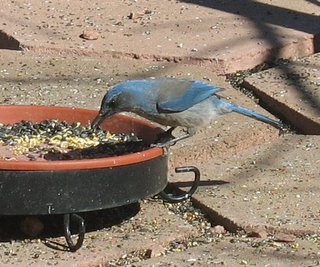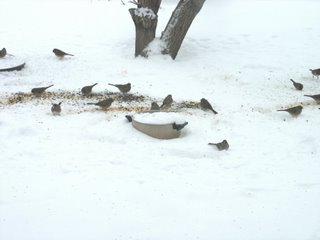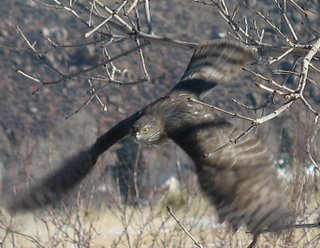They can be crockery, shoes I believe, even prisons—but today we are talking about, of course, birds! We occasionally are visited by large flocks of these noisy, colorful blackbirds. They fly in, land and devour any sunflower seeds they find, and take off again.
I should mention that we are at 6100 ft here, and a fair distance from a marsh or sizable wetland. High and dry.
I just found a reference that may explain how these successful little opportunists are managing. Writing in 1969, Paul Sears tells us:
“And the red-winged blackbird, previously known as a creature of swamp and marsh, has behaved in a most unorthodox fashion. Instead of politely vanishing as its customary home was done away with it is now nesting in soy bean fields and it has turned its attention from waving reaches of rush and reed to not dissimilar fields of ripening grain. Particularly given to tearing open the tender tips of green corn, the red-wing now ranks as a major pest. Usually we are indebted to foreign lands (as they are to us) for destructive imports. … But the versatility of the red-wing is proof that we can grow our own trouble-makers—always provided that we upset the old balance sufficiently.”
I should mention that we are at 6100 ft here, and a fair distance from a marsh or sizable wetland. High and dry.
I just found a reference that may explain how these successful little opportunists are managing. Writing in 1969, Paul Sears tells us:
“And the red-winged blackbird, previously known as a creature of swamp and marsh, has behaved in a most unorthodox fashion. Instead of politely vanishing as its customary home was done away with it is now nesting in soy bean fields and it has turned its attention from waving reaches of rush and reed to not dissimilar fields of ripening grain. Particularly given to tearing open the tender tips of green corn, the red-wing now ranks as a major pest. Usually we are indebted to foreign lands (as they are to us) for destructive imports. … But the versatility of the red-wing is proof that we can grow our own trouble-makers—always provided that we upset the old balance sufficiently.”
(from Lands Beyond the Forest, Paul B. Sears)
With all respect to Paul, one of America’s eminent ecologists, I don’t think I’m going to be able to consider red-wings as pests—but then, I have no fields of corn to defend. I am, rather, delighted to know that somebody can learn to profit from the messes we are making of our environment, and that some natives will survive in our highly modified world.
And I’m captivated by the concept that any small patch of wetness attracts cattails like a magnet. And that any small patch of cattails automatically generates red-wings. What would spring be without their trills?













